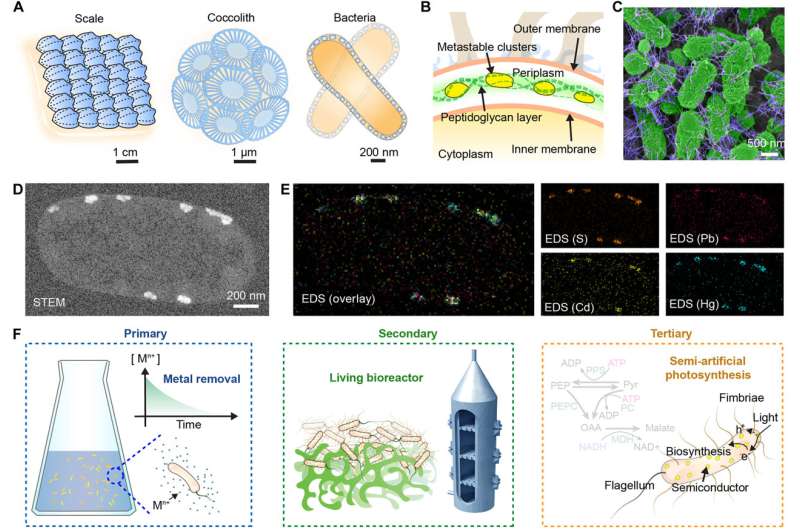This article has been reviewed according to Science X's editorial process and policies. Editors have highlighted the following attributes while ensuring the content's credibility:
fact-checked
peer-reviewed publication
trusted source
proofread
Exploring potential of periplasmic biosynthesis for efficient solar-driven chemical production

Researchers from the Shenzhen Institute of Advanced Technology (SIAT) of the Chinese Academy of Sciences (CAS) and the University of Chicago have discovered semiconductor nanocluster precipitation within the periplasmic space of Gram-negative bacteria for efficient solar-driven chemical production. The findings were published in Science Advances on July 21.
Biomineralization, a process involving the deposition of inorganic substances around biological cells and tissues, leads to the formation of composite materials. Bacteria have the ability to extract metal ions from their surroundings and produce functional materials.
The periplasmic space, gel-like matrix between the inner cytoplasmic membrane and the outer membrane of bacteria, offers unique opportunities for synthesizing and utilizing nanomaterials within a confined environment.
The periplasmic space of Gram-negative bacteria, characterized by abundant enzymes and peptidoglycan, provides a fertile ground for biomineralization. Additionally, Gram-negative bacteria have an electron transport chain closely connected to the periplasm, which facilitates the transfer of light-induced electron from semiconductor to the electron transport chain for intracellular reducing power regeneration. In-situ produced defect-rich semiconductor nanoclusters could elevate adenosine triphosphate (ATP) levels and enhance malate production under light condition.
Moreover, the team expanded the sustainability of periplasmic biosynthesis, including reducing heavy metal content, creating a living bioreactor, and constructing a semi-artificial photosynthesis system. By harnessing the power of biomineralization, the periplasmic biosynthesis showed immense potential as a platform for various sustainable applications.
"We believe that periplasmic biosynthesis can serve as an invaluable semi-artificial photosynthesis-based model for solar-driven bio-catalysis and sustainability," said Prof. Gao Xiang, co-author of the study.
Semiconductor biosynthesis is highly adaptable, allowing for controlled biocompatibility and efficient pairing with bacterial components, serving as a source of electrons for metabolic processes. Although the synthesis of metallic nanoparticles within the periplasm has been reported, studies on semiconductor-based biological interfaces in this space are rare, particularly in terms of bioregulation and multilevel sustainability.
The research team developed a non-genetic approach for semiconductor biomineralization in the periplasm of E. coli (the model organism of Gram-negative bacteria) and from microbial biohybrids. The semiconducting nanoclusters exhibited reduced crystallinity and were stabilized by the periplasmic peptidoglycan matrix, providing a softer interface with the bacterial cell. They investigated the underlying mechanisms of materials and biological characterization and discovered that semiconductor nanoclusters (e.g., CdS) were mediated by H2S-producing pathway.
The findings highlight the underexplored nature of the periplasmic space in bacteria, which is potential for constructing semiconductor-based biohybrids that can be applied in environmental remediation, living bioreactor fabrication, and semi-artificial photosynthesis for bioproduction and sustainability.
The periplasmic biomineralization forming semiconductor-bacteria biohybrid platform developed by the research team for solar-driven chemical production can potentially be extended to other bacteria or cells, enriching bioremediation applications with additional sustainability.
More information: Yiliang Lin et al, Periplasmic biomineralization for semi-artificial photosynthesis, Science Advances (2023). DOI: 10.1126/sciadv.adg5858
Journal information: Science Advances
Provided by Chinese Academy of Sciences




















